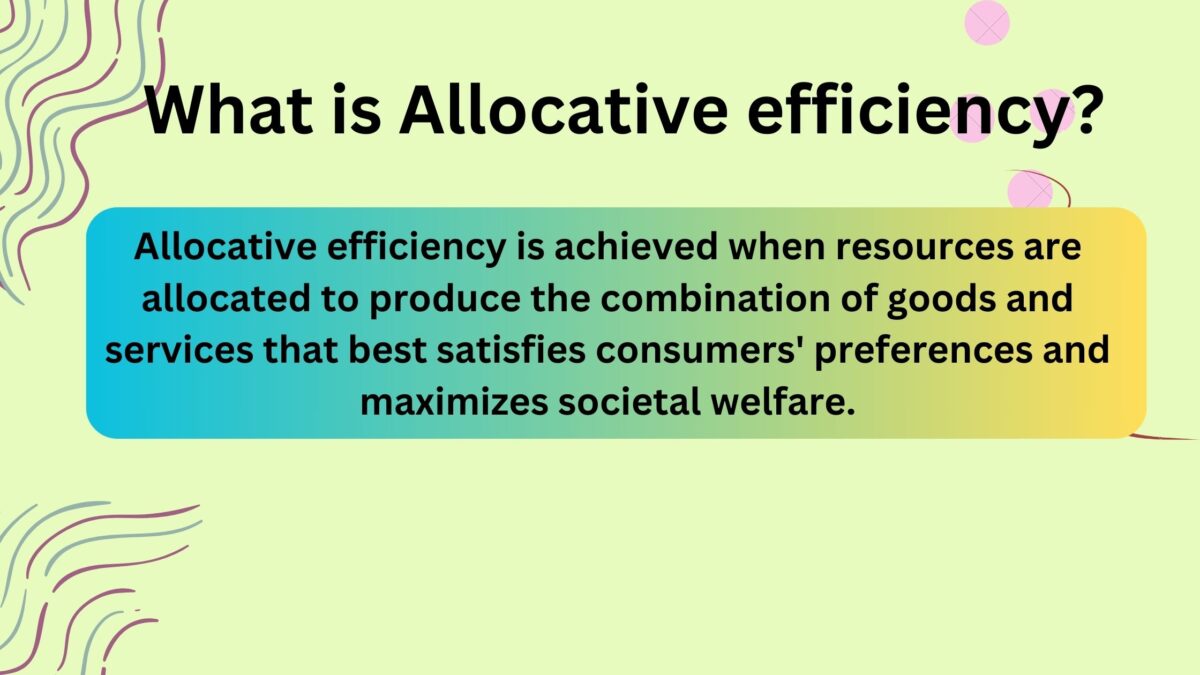Allocative efficiency: Definition, Meaning and Significance [updated 2024]

Allocative efficiency is a crucial concept in economics that refers to the optimal allocation of resources to maximize social welfare.
It occurs when resources are allocated in such a way that the marginal benefit equals the marginal cost for all goods and services in an economy.
In simpler terms, allocative efficiency is achieved when society produces the right mix of goods and services, where the value consumers place on those goods and services equals the cost of producing them.
Definition of Allocative Efficiency

Allocative efficiency is achieved when resources are allocated to produce the combination of goods and services that best satisfies consumers’ preferences and maximizes societal welfare. It involves the efficient distribution of resources to produce the goods and services that are most valued by society.
Characteristics of Allocative Efficiency
1. Marginal Benefit Equals Marginal Cost:
At allocative efficiency, the marginal benefit derived from consuming an additional unit of a good or service is equal to the marginal cost of producing it. This ensures that resources are not wasted and are allocated most efficiently.
2. Pareto Efficiency:
It is often associated with Pareto efficiency, where it is impossible to make one individual better off without making another individual worse off. In other words, resources are allocated in such a way that no one can be made better off without making someone else worse off.
3. Consumer Sovereignty:
Allocative efficiency reflects the principle of consumer sovereignty, where the preferences and choices of consumers determine the allocation of resources. Producers respond to consumer demand by producing the goods and services that consumers value the most.
Importance of Allocative Efficiency
1. Maximizes Social Welfare:
It ensures that resources are allocated to produce the goods and services that provide the greatest satisfaction to society. This maximizes overall social welfare and enhances economic prosperity.
2. Reduces Waste:
When resources are allocated efficiently, there is minimal waste in the production process. This leads to higher levels of productivity and economic output, as resources are used in their most productive capacity.
3. Promotes Innovation:
Allocative efficiency encourages firms to innovate and improve their production processes to better meet consumer preferences. Firms that fail to adapt to changing consumer demands risk becoming inefficient and losing market share.
4. Enhances Economic Growth:
By allocating resources to their most productive uses, allocative efficiency promotes economic growth and development. Efficient resource allocation fosters investment, innovation, and technological progress, driving long-term economic prosperity.
Measurement of Allocative Efficiency
Assessing allocative efficiency involves comparing the marginal benefit (MB) and marginal cost (MC) of producing and consuming goods and services. Several methods can be used to measure allocative efficiency, including:
1. Price Mechanism:
In a competitive market, allocative efficiency is achieved when the price of a good or service reflects its marginal cost of production. If the price exceeds the marginal cost, there is under allocation of resources, whereas if the price is below the marginal cost, there is an allocation of resources.
2. Consumer Surplus and Producer Surplus:
Allocative efficiency can be measured by examining consumer surplus (the difference between what consumers are willing to pay and what they pay) and producer surplus (the difference between the price received by producers and the marginal cost of production). Allocative efficiency is achieved when total surplus (consumer surplus + producer surplus) is maximized.
3. Social Welfare Functions:
Economists use social welfare functions to evaluate the overall welfare of society based on the allocation of resources. These functions take into account various factors, including consumer preferences, production costs, and income distribution, to assess allocative efficiency.
Factors Affecting Allocative Efficiency
Several factors influence the degree of allocative efficiency in an economy:
1. Market Structure:
The degree of competition within markets affects allocative efficiency. In perfectly competitive markets, allocative efficiency is achieved because prices reflect marginal costs. In monopolistic or oligopolistic markets, prices may deviate from marginal costs, leading to allocative inefficiency.
2. Government Intervention:
Government policies and regulations can either promote or hinder allocative efficiency. For example, price controls, subsidies, taxes, and regulations can distort market signals and lead to the misallocation of resources.
3. Information Availability:
Access to information plays a crucial role in allocative efficiency. When consumers and producers have perfect information about prices, quality, and availability of goods and services, they can make more informed decisions, leading to better resource allocation.
4. Externalities:
Externalities, such as pollution or positive spillover effects from innovation, can lead to allocative inefficiency. When the social costs or benefits of production or consumption are not reflected in market prices, resources may be misallocated.
5. Income Distribution:
The distribution of income affects allocative efficiency by influencing consumer preferences and purchasing power. Unequal income distribution can lead to disparities in access to goods and services, affecting the optimal allocation of resources.
Implications for Economic Policy
Efforts to enhance allocative efficiency often involve a combination of market-based mechanisms and government intervention:
1. Promoting Competition:
Policies that promote competition in markets can enhance allocative efficiency by ensuring that prices reflect marginal costs. This may involve antitrust measures, deregulation, and measures to prevent barriers to entry.
2. Correcting Market Failures:
Government intervention may be necessary to correct market failures, such as externalities or public goods. This could include implementing Pigouvian taxes or subsidies, establishing property rights, or providing public goods directly.
3. Investing in Information Infrastructure:
Improving access to information through education, technology, and transparency initiatives can enhance allocative efficiency by empowering consumers and producers to make better-informed decisions.
4. Redistributive Policies:
Addressing income inequality through redistributive policies can improve allocative efficiency by ensuring that resources are allocated based on need and demand rather than solely on purchasing power.
5. Monitoring and Evaluation:
Regular monitoring and evaluation of market outcomes and government policies are essential to assess allocative efficiency and identify areas for improvement. This may involve collecting data, conducting cost-benefit analyses, and soliciting feedback from stakeholders.
Conclusion
Allocative efficiency is a fundamental concept in economics that underpins the optimal allocation of resources to maximize societal welfare. Achieving allocative efficiency requires aligning marginal benefits with marginal costs across all goods and services in an economy.
While markets play a central role in allocating resources efficiently, government intervention may be necessary to correct market failures and promote competition. By promoting allocative efficiency, policymakers can foster economic growth, reduce waste, and enhance overall social welfare.
Also read:
- National Domestic Product (NDP)
- Gross National Product (GNP)
- Understanding of NNP (Net Nation Product)
- 15 FAQ on Personal Finance
- Gross Domestic Product (GDP)
- 15 FAQ on 80-20 Rule (Pareto Principle)
- Depreciation- Meaning, Definition, Types and Calculation
- Fiscal Deficit- Definition, Calculation and Significance
- Balance of Payments (BoP): Explained
- Balance of Trade: Definition, Measurement and Significance






